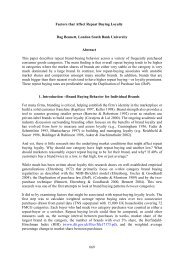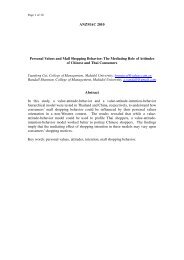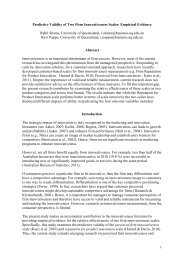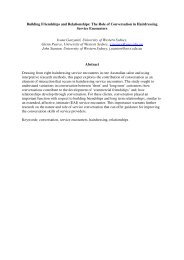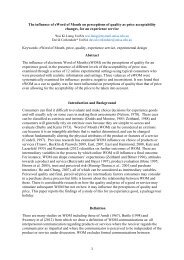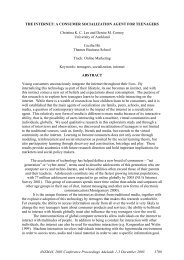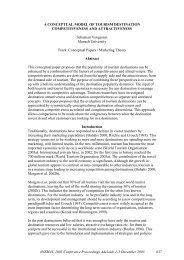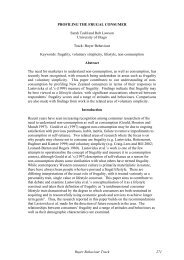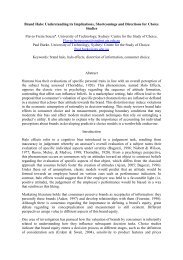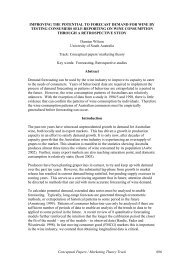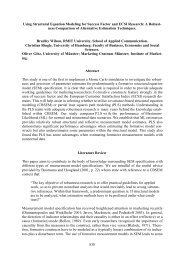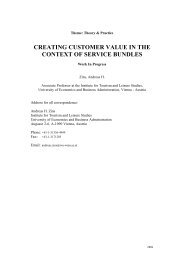amj Australasian Marketing Journal - ANZMAC
amj Australasian Marketing Journal - ANZMAC
amj Australasian Marketing Journal - ANZMAC
You also want an ePaper? Increase the reach of your titles
YUMPU automatically turns print PDFs into web optimized ePapers that Google loves.
Flexibility: Online promotional campaigns can be implemented<br />
quicker and often for less cost than many offline promotional<br />
campaigns (Zeff and Aronson, 1997). Customer<br />
response can be measured immediately. Bad promotional<br />
campaigns are deleted quickly if they prove ineffective (Zeff<br />
and Aronson, 1997).<br />
Interactivity: The customer chooses to be involved in the<br />
promotional process. This decision making process involves,<br />
for example, using demonstration copies of software, developing<br />
customised orders and commenting on previous experiences<br />
by posting book or wine reviews.<br />
Each of the above online promotional advantages illustrates<br />
why the Internet should be considered strategically within the<br />
firm s overall marketing strategy. But Internet marketing has<br />
yet to come of age.<br />
As Yahoo! reels from advertising shortfalls and other highflying<br />
dot.coms tumble from cyberspace, others question webbased<br />
advertising (Reis and Reis, 2000; Tanikawa, 2001).<br />
Emerging Internet revenue sources and marketing applications<br />
include customer relationship management, targeted<br />
emails and interactive polling (Newell, 2000). Each of these<br />
offers a new dimension to online marketing, raising the issue<br />
of how do advertisers perceive the Internet as a marketing<br />
tool. The literature suggests advantages of using the Internet<br />
over existing media, but uncertainty about the future marketing<br />
potential.<br />
Consumers perceive web advertising positively, rating it as<br />
valuable, informative, not particularly irritating and a benefit<br />
to companies using it (Ducoffe, 1996). Ducoffe also found<br />
that consumers have a strong association between advertising<br />
value and attitude toward Web advertising.<br />
Similar to Ducoffe s (1996) research, Eighmey (1997) examined<br />
users perceptions of commercial Web sites. His pilot<br />
study and field application found user benefits of commercial<br />
sites similar to benefits associated with television commercials<br />
reported in previous uses and gratification studies.<br />
Eighmey also found that value-added information that reaches<br />
users in a time commensurate with the perceived information<br />
value, attracts Web site users. His research suggests that<br />
mass communication s uses and gratification perspective<br />
applies to the Web.<br />
Researching traditional advertisements, Maddox and Mehta s<br />
(1997) study of Web addresses suggested that both Internet<br />
users and nonusers noted uniform resource locators (urls) in<br />
mass media ads. Consumers perceived advertisers with Web<br />
addresses as more customer-oriented, responsive, informative,<br />
high tech, sophisticated, and likely to stay in business<br />
longer.<br />
As for online ads, Briggs and Hollis (1997) studied banner<br />
advertising on the Web and its impact on consumers attitudes<br />
and behavioural response. Their findings suggest that Web<br />
Perceptions of Internet <strong>Marketing</strong><br />
banners help increase brand awareness, remind consumers of<br />
a brand s existence, stimulate latent brand associations, and<br />
can affect attitudes toward the brand and, ultimately, increase<br />
probability of purchase.<br />
Bush, Bush and Harris (1998) study of U.S. advertisers indicated<br />
that the Internet was important within the promotional<br />
campaign, particularly for providing product information. But<br />
advertisers were uncertain about the Internet s competitive<br />
advantage and whether it would lead to transactions. The<br />
uncertainty is somewhat due to the newness of using the<br />
Internet within their promotional strategies. It should be noted<br />
though that advertisers perceived that growth in Internet use<br />
would be considerable in the next 12 months.<br />
Along with the advantages of Internet use, there are barriers<br />
to its implementation and use, which influence the advertiser<br />
s perception of the future of the Internet. Such barriers<br />
include security, privacy, technological advancements and<br />
non-technological issues. This research divided barriers into<br />
three sections: security and privacy, technological and nontechnological<br />
issues.<br />
In a recent study on E-commerce barriers for Australian and<br />
Singaporean organisations, the largest barrier to adoption was<br />
the cost of Internet setup (Chong & Pervan, 2000) classified<br />
as a non-technological barrier in this study. The next two<br />
highest barriers were lack of in-house expertise (a technological<br />
barrier) and security issues (security and privacy barrier)<br />
(Chong & Pervan, 2000).<br />
2.4 Cultural influences in Australia and Taiwan<br />
This research investigated Internet perceptions of advertisers<br />
between predominately eastern and western countries:<br />
Australia and Taiwan. This section discusses how Australia<br />
and Taiwan differ along Hofstede s (1991) cultural dimension<br />
of uncertainty avoidance.<br />
Hofstede s (1991) other cultural dimensions, power distance,<br />
individualism and masculinity were not considered in this<br />
research. Power distance describes the relative dependence of<br />
relationships (Hofstede, 1991) and is not considered important<br />
in an advertiser s perception of the Internet.<br />
Individualism describes the relative importance placed on ties<br />
between individuals (Hofstede, 1991) and should not pertain<br />
to their perception of the Internet. This dimension may be<br />
important in the individual consumers use of the Internet but<br />
this research did not investigate individual consumer s<br />
Internet use. Masculinity describes the relative difference in<br />
gender values between males and females (Hofstede, 1991).<br />
Masculinity may determine how different roles are portrayed<br />
through the Internet but is not considered important in the<br />
advertiser s perception of the Internet as a marketing tool.<br />
The Uncertainty Avoidance Index (UAI) considers the tolerance<br />
to ambiguity in society described as the extent to which<br />
the members of a culture feel threatened by uncertain or<br />
<strong>Australasian</strong> <strong>Marketing</strong> <strong>Journal</strong> 9 (1), 2001 35



